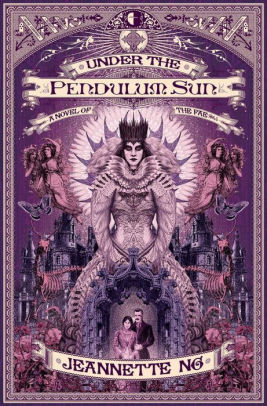A Review of Jeanette M. Ng’s Under the Pendulum Sun (Angry Robot, 2017).
By Stephen Hong Sohn
Well, Jeanette M. Ng’s Under the Pendulum Sun (Angry Robot, 2017) has, at least for me, one of the more intriguing premises for new reads I’ve encountered this year. This rather anemic description over at B&N doesn’t give too much away:
“Catherine Helstone’s brother, Laon, has disappeared in Arcadia, legendary land of the magical fae. Desperate for news of him, she makes the perilous journey, but once there, she finds herself alone and isolated in the sinister house of Gethsemane. At last there comes news: her beloved brother is riding to be reunited with her soon – but the Queen of the Fae and her insane court are hard on his heels.”
I suppose this summary does a strong enough job of giving us the basics, but there are a couple of key individuals that Catherine Helstone meets, while living at Gethsemane. First, she arrives there alongside a changeling named Ariel Davenport. Ariel is gregarious and seemingly always hungry. They are attended to by a kind of butler, a gnome named Mr. Benjamin. Mr. Benjamin is key to this story because the reason why Laon is in Arcadia in the first place is that he is there to proselytize. Yes, he is seeking to establish Christianity in the land of the Fae. Finally, there is a mysterious manager to the house, a female fae named the Salamander, who occasionally makes her presence known, but otherwise sticks to the shadows. Ng adds some mystery into the equation because there was a previous missionary sent out to Arcadia (a man by the name of Roche) who disappears and whose whereabouts are unknown. While Catherine waits for Laon to arrive, she gets into some mischief leafing through Roche’s old journals, finding out that he was trying to discern fairy language, something he believed was called Enochian. His attitude was that he would be able to convert more fae if he could speak with them in a common language. In any case, Laon eventually returns, but his arrival only brings more questions: why is he so cold to Catherine? And what about all of the strange goings-on at Gethsemane, including the fact that she once bumped into a strange, seemingly mad woman in black? If you’re feeling shades of Jane Eyre, you’re not wrong at all, because Ng is obviously playing with a lot of these more gothic tropes. But, here is where I pause—and I am providing you with my spoiler warning here, so do not read on at this point unless you want to know all of the tricks that Ng has up her sleeve—because Ng stages at least two surprises in the back half of the book. The first is one that she telegraphs with too much information: Laon and Catherine are apparently in love with each other. The second is that Catherine discovers that she’s actually a changeling, a fact which seems to make it more acceptable (at least from what it seemed like in the text) that they were embarking in an incestuous relationship with each other. The “final” twist that Ng provides us is the fairylands may be some sort of variation on hell and that the fairies exist to create dilemmas for humans that ultimately lead them into sin. In this particular case, Catherine’s arrival into the land of the fae tempts Laon to the point where he gives in to his lust. Catherine thus becomes a pawn in a larger “game” in which the fae can cause Laon and Catherine’s collective fall. Finally, Catherine’s revelation that she is a changeling is discovered to be false. Indeed, when Ariel Davenport tells Catherine to kill her (instead of allowing Queen Mab to do so during a hunt), it’s because Ariel Davenport was led to believe that Catherine was a changeling, exactly so that Catherine would end up killing her and leading all the characters down their path of ruin. Queen Mab thus becomes the architect of many characters’ downfalls, but the conclusion sees Catherine and Laon realize that, though they have now sinned, their quests are ever more important. Why not try to do what they came there to do, they ask themselves, despite the fact that they may indeed be in hell. The novel is compelling and something more akin to a novel of ideas than a speculative fiction in many ways. But Ng takes a little bit too much time to get us to the “meat” of the matter. Indeed, Catherine isn’t left with much to do until Ariel mistakenly tells her that’s she’s a changeling and must murder Ariel (as a kind of mercy killing). From that point forward, the pacing finally moves at the speed it should have. Otherwise, Ng’s incredibly gifted at world-building. Gethsemane and the fairylands are otherworldly, simultaneously beautiful and menacing, with creatures and entities fit for Alex Garland’s filmic adaptation of Annihilation from the Southern Reach trilogy.
Buy the Book Here!
Review Author: Stephen Hong Sohn
Review Editor: Xiomara Forbez
If you have any questions or want us to consider your book for review, please don't hesitate to contact us via email!
Prof. Stephen Hong Sohn at ssohnucr@gmail.com
Xiomara Forbez, PhD Candidate in Critical Dance Studies, at xforb001@ucr.edu